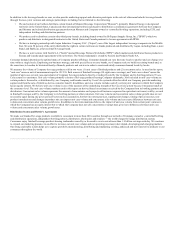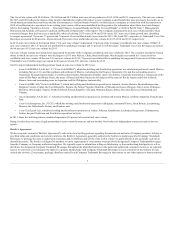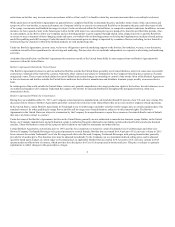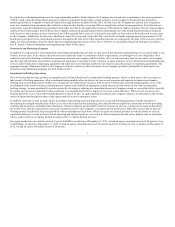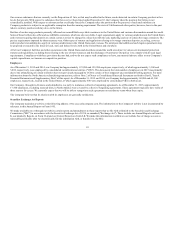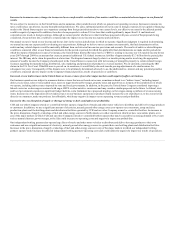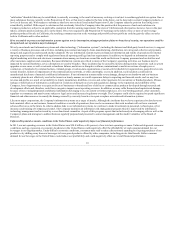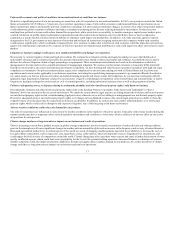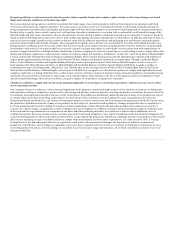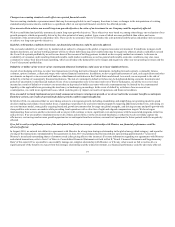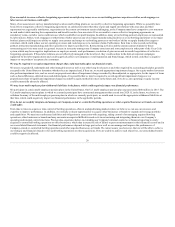Coca Cola 2015 Annual Report Download - page 15
Download and view the complete annual report
Please find page 15 of the 2015 Coca Cola annual report below. You can navigate through the pages in the report by either clicking on the pages listed below, or by using the keyword search tool below to find specific information within the annual report.
Fluctuations in foreign currency exchange rates could have a material adverse effect on our financial results.
We earn revenues, pay expenses, own assets and incur liabilities in countries using currencies other than the U.S. dollar, including the euro, the Japanese yen,
the Brazilian real and the Mexican peso. In 2015, we used 71 functional currencies in addition to the U.S. dollar and derived $23.9 billion of net operating
revenues from operations outside the United States. Because our consolidated financial statements are presented in U.S. dollars, we must translate revenues,
income and expenses, as well as assets and liabilities, into U.S. dollars at exchange rates in effect during or at the end of each reporting period. Therefore,
increases or decreases in the value of the U.S. dollar against other currencies affect our net operating revenues, operating income and the value of balance
sheet items denominated in foreign currencies. Because of the geographic diversity of our operations, weaknesses in some currencies might be offset by
strengths in others over time. We also use derivative financial instruments to further reduce our net exposure to foreign currency exchange rate fluctuations.
However, we cannot assure you that fluctuations in foreign currency exchange rates, particularly the strengthening of the U.S. dollar against major currencies
or the currencies of large developing countries, would not materially affect our financial results.
If interest rates increase, our net income could be negatively affected.
We maintain levels of debt that we consider prudent based on our cash flows, interest coverage ratio and percentage of debt to capital. We use debt financing
to lower our cost of capital, which increases our return on shareowners' equity. This exposes us to adverse changes in interest rates. When and to the extent
appropriate, we use derivative financial instruments to reduce our exposure to interest rate risks. We cannot assure you, however, that our financial risk
management program will be successful in reducing the risks inherent in exposures to interest rate fluctuations. Our interest expense may also be affected by
our credit ratings. In assessing our credit strength, credit rating agencies consider our capital structure and financial policies as well as the consolidated
balance sheet and other financial information of the Company. In addition, some credit rating agencies also consider financial information of certain of our
major bottlers. It is our expectation that the credit rating agencies will continue using this methodology. If our credit ratings were to be downgraded as a
result of changes in our capital structure; our major bottlers' financial performance; changes in the credit rating agencies' methodology in assessing our credit
strength; the credit agencies' perception of the impact of credit market conditions on our or our major bottlers' current or future financial performance and
financial condition; or for any other reason, our cost of borrowing could increase. Additionally, if the credit ratings of certain bottlers in which we have
equity method investments were to be downgraded, such bottlers' interest expense could increase, which would reduce our equity income.
We rely on our bottling partners for a significant portion of our business. If we are unable to maintain good relationships with our bottling partners, our
business could suffer.
We generate a significant portion of our net operating revenues by selling concentrates and syrups to independent bottling partners. As independent
companies, our bottling partners, some of which are publicly traded companies, make their own business decisions that may not always align with our
interests. In addition, many of our bottling partners have the right to manufacture or distribute their own products or certain products of other beverage
companies. If we are unable to provide an appropriate mix of incentives to our bottling partners through a combination of pricing and marketing and
advertising support, or if our bottling partners are not satisfied with our brand innovation and development efforts, they may take actions that, while
maximizing their own short-term profits, may be detrimental to our Company or our brands, or they may devote more of their energy and resources to
business opportunities or products other than those of the Company. Such actions could, in the long run, have an adverse effect on our profitability.
If our bottling partners' financial condition deteriorates, our business and financial results could be affected.
We derive a significant portion of our net operating revenues from sales of concentrates and syrups to independent bottling partners and, therefore, the
success of our business depends on our bottling partners' financial strength and profitability. While under our agreements with our bottling partners we
generally have the right to unilaterally change the prices we charge for our concentrates and syrups, our ability to do so may be materially limited by our
bottling partners' financial condition and their ability to pass price increases along to their customers. In addition, we have investments in certain of our
bottling partners, which we account for under the equity method, and our operating results include our proportionate share of such bottling partners' income
or loss. Our bottling partners' financial condition is affected in large part by conditions and events that are beyond our and their control, including
competitive and general market conditions in the territories in which they operate; the availability of capital and other financing resources on reasonable
terms; loss of major customers; or disruptions of bottling operations that may be caused by strikes, work stoppages, labor unrest or natural disasters. A
deterioration of the financial condition or results of operations of one or more of our major bottling partners could adversely affect our net operating revenues
from sales of concentrates and syrups; could result in a decrease in our equity income; and could negatively affect the carrying values of our investments in
bottling partners, resulting in asset write-offs.
13



